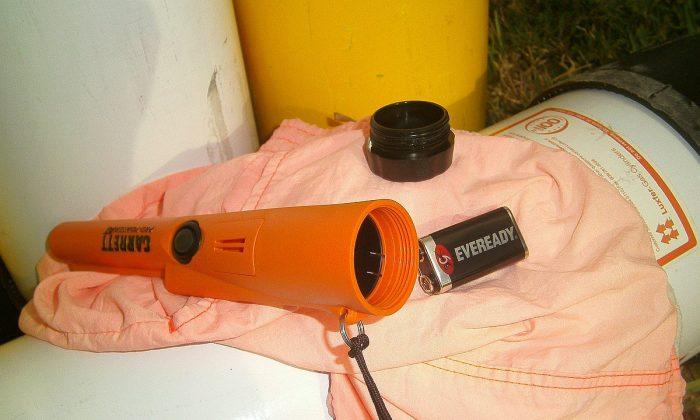The invention was long overdue. I’ve dug many holes on land to uncover finds my
detector signaled were hidden in the earth. I’ve searched the world for
shipwrecks and sunken treasure. I’ve climbed mountains looking for lost gold and
silver mines. For all of that I’ve damaged my share of valuable artifacts. I
remember vividly bringing bags of coins aboard the dive boat, dumping them out
on deck and watching while clumps were broken apart with hammers. The excitement
was just too much to contain careless attack on numismatic finds.
With the advent of the Garrett Pro-Pointer it is possible to pin point the
exact location of a hit. This isolates the find and enables its careful
excavation. Far too many Civil War belt buckles, gold jewelry even lead musket
balls have been damaged when digging them out. Rain and mud doesn’t stop me and
I often detect in surf and underwater.
I’ve gone through the phase of using plastic bags to protect delicate
electronics of my detectors. I use my Garrett Sea-Hunter on beaches and
underwater and in rain and snow. I learned the hard way that water, no matter
how little, and electronics are incompatible.
I had an assignment to cover marine mammals at a well known theme park. The big
show was when trainers had the orca leap out of the water and splash visitors.
The front rows were marked as splash zones. Kids loved it. Summer in Florida is
hot. The refreshing cold water in the orca pool made them scream with glee. No
matter their parents would have a wet lump in the car.
I went all the way back to the far rear wall of the amphitheater. I put a zoom
lens on my expensive SLR camera and waited. One great shot after another. Until
the orca splashed its fatal splash. Yep, a drop, only a drop, came all the way
back and landed on the shutter release button. That was enough to seep inside
and fry the electronics. It was a $450 repair. That’s when serious use of
plastic bags took place for all my sensitive electronic equipment, mental
detectors included. I switched to the use Garrett’s Sea Hunter exclusively for
beach and surf. Sand and dust also work havoc with equipment.
Then the invention of the century—well after computer chips, that is. Charles
Garrett and his engineers brought out their AT Gold. Using waterproof ear phones
the detector is waterproof to ten feet. Rain, snow, creeks in gold rush areas
and surf detecting do not phase it. I kept my original Pro-Pointer under my coat
or poncho to protect it; used a plastic bag to wrap it when detecting in the
rain. Pro Pointer’s hard plastic snoot is waterproof so I had no fear jabbing it
into mud. It cleaned off with a damp cloth. The electronics were not waterproof.
I always protected it and kept it out of water.
Now Garrett has brought out a waterproof model. Their Pro-Pointer AT (All
Terrain) solves the dilemma of using it in rain or even underwater. The
Pro-Pointer AT is rated to be waterproof for 10 feet underwater. Manufacturer’s
suggested retail pricing started out the same as their other model, however the
original Garrett Pro-Pointer price was dropped $20 when the AT came out. The
Pro-Pointer AT comes with holster and a clip where a lanyard can be attached.
Garrett’s bright orange color insures easy visibility even in brackish water.
The invention is opportune and ranks with clever innovation in metal detecting.
“It is something our customers asked for. They’ve wanted a waterproof model, a
lanyard clip and a stealth or silent mode,” Steve Moore, Garrett’s Director of
Marketing, said.
“It is a big improvement in terms of features with greater flexibility to
overcome environmental challenges. It can be tuned for use in salt water and
mineralized ground,“ Steve added. ”I’m in the woods, creeks, I stick my arm into
water. I’m not concerned getting the Pro-Pointer AT wet.”
Garrett’s Pro-Pointer AT weighs only 6.5 ounces. There is a waterproof cap at
the end that is seated against a rubber ‘O’ ring. As with all waterproof ‘O’
ring seals care must be used when replacing the battery cap to insure that the
‘O’ ring is lubricated with silicone grease. Not too much, just enough applied
with the tip of a finger to insure the seal. At the same time a finger can
insure there is no sand, grit or hair on the ‘O’ ring that will interfere with
its watertight integrity.
The Pro-pointer AT is 9“ long, it is 1.5” thick with a tapering end. It comes
with a 9 volt battery installed. Replacement batteries or rechargeable batteries
provide about 16 hours of operation with carbon batteries, 30 hours operating
time with alkaline batteries. Pro-Pointer’s operating frequency is 11.5 kHz.
I have never had trouble bringing my Pro-Pointer through airport security,
however, I have been questioned about what it was. I therefore place it in my
checked baggage wrapped in bubble pack. To prevent pressure issues I unscrew the
battery compartment knob and leave it off, carefully wrapped in bubble pack.
Sealed objects are affected by decreases in atmospheric pressure at altitude.
Baggage compartments are not usually pressurized. That simply means that an
object sealed at normal atmospheric pressure will pop out against its seal when
the pressure is decreased. If you need an illustration remember the peanut or
chip bag served aboard aircraft. Sealed at atmospheric pressure, they puff up on
take off. Commercial aircraft begin cabin pressurization at about three thousand
feet. Perhaps puffy chip bags are memories of long ago when complimentary snacks
were served in the halcyon days of air travel; point made.
The Pro-Pointer AT has automatic or manual tuning. Beach sand and salt water
can play havoc with metal detectors since they are highly mineralized. It easy
to tune out detection of wet sand, minerals in the ground and salt water. Simply
hold the Pro-Pointer AT’s point to the salt water or sand and press the on-off
button quickly. Sensitivity can also be reduced to eliminate response to
mineralization or salt water. I prefer to keep sensitivity on high and ’retune’
so I do not miss small gold objects.
Garrett’s AT Pro-Pointer can be adjusted for sensitivity. It can also be set
for silent or vibration only mode. Changing settings is easy. The on-off button
is held for two seconds. A single beep, then dual tone beep, then the LED light
flashes to indicate readiness for adjustment. Pressing the button again sounds
the current setting. Each subsequent pressing of the button changes the three
settings from minimum sensitivity to maximum with audio. Continuing to depress
the on-off button changes vibration from minimum to maximum sensitivity in
silent mode. Holding the on-off button for two seconds causes the Pro-Pointer AT
to exit its adjustment mode with a dual tone beep.
The Pro-Pointer AT is equipped with an LED flashlight that provides a directed
beacon along the tapered edge. The audio speaker is waterproof. A scraping blade
along the length of the tapered edge makes it handy to move sand to isolate
small finds. The Pro-Poiner At has a 360 degree detection area. It even has an
‘I’m Lost’ alarm. When left on for five minutes without the button being pressed
it will emit warning chirps. After five minutes of chirping it will power off
automatically. I use one of my underwater light lanyards to hold the Pro-Pointer
AT to my wrist when diving.
The Pro-Pointer AT is a great alternative to using the larger, bulkier Sea
Hunter underwater. While the Sea Hunter is rated for 200 feet and the
Pro-Pointer AT for only 10 feet, most of my hunts for shipwrecks and lost
jewelry off Florida’s coast are just off the beach in shallow water.
The late Bob ‘Frogfoot’ Weller and his team of divers found the amazing
‘Queen’s Jewels,’ gold and diamond studded brooches, pendants and earrings, in
just 8 feet of water. Inshore shallow reefs have nooks and crannies where
snorkelers search for coins and lost jewelry.
When the Atlantic Ocean is flat calm and there are no waves I like to hunt
along beaches that front luxury hotels. It is among the rock ledges at one spot
where hotel guests swim. Waves knock them over or they stumble on the rocks.
Their religious ornaments, rings and jewelry fall into the surf. I cannot get my
Garrett Sea Hunter head into cracks in the rocks. Now I have the perfect tool. I
use the Pro-Pointer AT in the surf instead of my larger detector.
Remember people lose things in waist high water. Rings slip off fingers, they
forget to lock their gold jewelry in the hotel safe. Swimmers lose their balance
and objects of value, especially heavy gold objects, sink into the sand to coral
or rock substrate. Once a signal is detected a little hand fanning is usually
all that is necessary to recover the object.
For more information about Garrett’s new Pro-Pointer AT call them toll-free at
1-800-527-4011 or visit their website at www.garrett.com.





